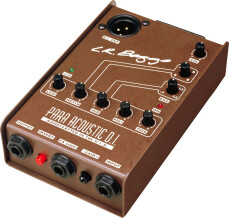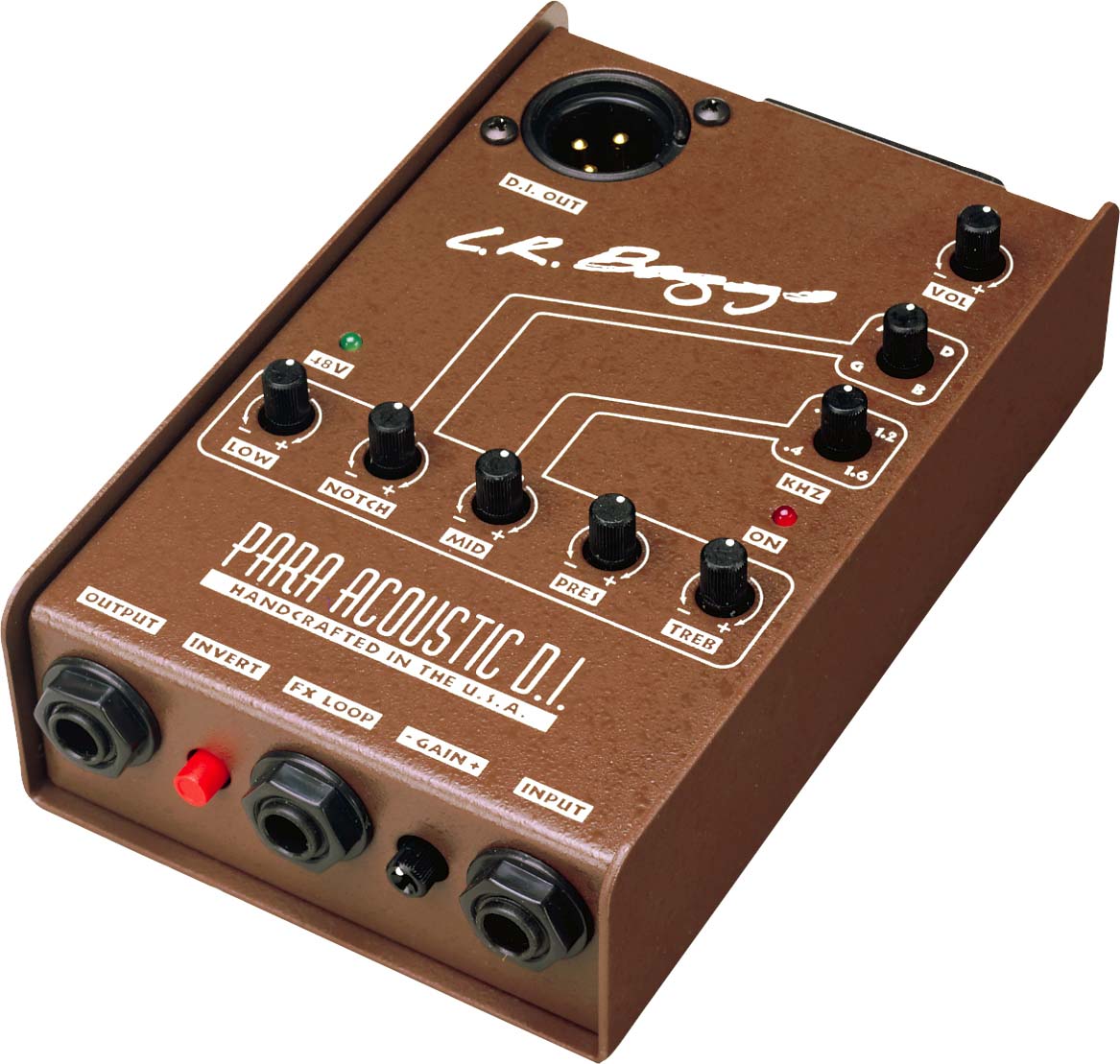View other reviews for this product:
« One of the best acoustic guitar preamps, hands down. »
Published on 04/03/15 at 12:31
Value For Money :
Correct
Audience:
Anyone
Overview
I purchased the L.R. Baggs Para Acoustic DI to make my $200 acoustic guitar sound like an $2000 acoustic guitar in live sound applications, and it gets the job done. I choose this particular unit based on multiple recommendations over the years from friends and fellow musicians, and I was glad I finally did. For the price, it's difficult to beat the versatility, stability, and overall sound of this DI/Preamp combo. It's a very simple box to use, but the parameters are incredibly adjustable for different environments--including controls for EQ, gain, phase inversion, and frequency attenuation. All in all, it's a small box, with a huge sound.
My Experience
I bought my DI used on the Internet for a considerably lower cost than its retail of $169, which even then is a great price for the quality of this unit. I own an Alvarez RD8 (less than $200) acoustic guitar that has a piezo under-saddle pickup I installed myself (the piezo pickup came from an $120 acoustic guitar!) On its own, my plugged-in guitar sounds dead, projects bass frequencies too heavily, and will tend to feedback very often. But when I plug my Alvarez into the L.R. Baggs DI, I can tweak the cheap piezo pickup to a sound that contends with high-end guitars from Martin, Taylor, and the like.
This kind of power is made possible because the DI is equipped with a world class 5-Band EQ, far exceeding the limitations of a simple 3-Band EQ of Bass, Mid, and Treble. The L.R. Baggs DI includes controls for Bass, Low-Mid, High-Mid, Presence, and Treble. Instantly, I can take the overly-heavy bass and mid-range feedback out of the equation, boost the presence for extra clarity, and adjust the overall gain accordingly so the signal of my guitar is free from distortion. The phase inversion also seems like a useful 'emergency' tool, but I have not needed it yet in my own experience.
Now, bear in mind that I personally use this DI too make a cheap guitar sound great, but that doesn't mean this product is only for cheap guitars. I've known other musicians who will pair this DI box with $3,000 Taylor guitars, or even $500-1000 brands like Seagull, Takamine, and Breedlove. Every guitar comes with a different build, style, and set of electronics, and nearly all of them have their own setbacks when it comes to plugging the guitar into a sound system. That's where a versatile DI/Preamp like the L.R. Baggs comes in handy, whether its used to improve overall sound quality, or simply resolve the multitude of issues related to live sound.
A Few Frustrations
Like anything else, the L.R. Baggs is not perfect, particularly in the area of design.
From what I understand, this DI box has been around for over a decade, and it shows in the design choices made by L.R. Baggs. For example, unlike common stomp boxes of the 21st century, the Para Acoustic DI cannot be powered by a 9V AC adaptor. The only two options for power are a 9V battery or 48V phantom power routed from the unit it's plugged into (I personally hate using batteries). Luckily, nearly all live sound/studio environments have phantom power available, but I'm waiting for some circumstance in the future when it is not and I'm fresh out of batteries…I pray that day never comes.
The other frustration I have with the box is the XLR output placement. For some reason, L.R. Baggs made the odd decision to place an XLR output on top of the unit, where it is very prone to moving around and ultimately wearing down the output faster. You might think an updated version where the output is ergonomically placed on the side would be in order, but the box has remained the same for years. Strangely enough, there is also a balanced TRS output, and it is conveniently located on the side. You can't win them all, I guess.
Bottom-Line
For less than $200, you can give your cheap acoustic electric guitar a professional sound, or give your expensive acoustic electric guitar some added versatility. In my years of using the L.R. Baggs DI, I would say the cost is well worth the outcome, no matter what you use it for.
I purchased the L.R. Baggs Para Acoustic DI to make my $200 acoustic guitar sound like an $2000 acoustic guitar in live sound applications, and it gets the job done. I choose this particular unit based on multiple recommendations over the years from friends and fellow musicians, and I was glad I finally did. For the price, it's difficult to beat the versatility, stability, and overall sound of this DI/Preamp combo. It's a very simple box to use, but the parameters are incredibly adjustable for different environments--including controls for EQ, gain, phase inversion, and frequency attenuation. All in all, it's a small box, with a huge sound.
My Experience
I bought my DI used on the Internet for a considerably lower cost than its retail of $169, which even then is a great price for the quality of this unit. I own an Alvarez RD8 (less than $200) acoustic guitar that has a piezo under-saddle pickup I installed myself (the piezo pickup came from an $120 acoustic guitar!) On its own, my plugged-in guitar sounds dead, projects bass frequencies too heavily, and will tend to feedback very often. But when I plug my Alvarez into the L.R. Baggs DI, I can tweak the cheap piezo pickup to a sound that contends with high-end guitars from Martin, Taylor, and the like.
This kind of power is made possible because the DI is equipped with a world class 5-Band EQ, far exceeding the limitations of a simple 3-Band EQ of Bass, Mid, and Treble. The L.R. Baggs DI includes controls for Bass, Low-Mid, High-Mid, Presence, and Treble. Instantly, I can take the overly-heavy bass and mid-range feedback out of the equation, boost the presence for extra clarity, and adjust the overall gain accordingly so the signal of my guitar is free from distortion. The phase inversion also seems like a useful 'emergency' tool, but I have not needed it yet in my own experience.
Now, bear in mind that I personally use this DI too make a cheap guitar sound great, but that doesn't mean this product is only for cheap guitars. I've known other musicians who will pair this DI box with $3,000 Taylor guitars, or even $500-1000 brands like Seagull, Takamine, and Breedlove. Every guitar comes with a different build, style, and set of electronics, and nearly all of them have their own setbacks when it comes to plugging the guitar into a sound system. That's where a versatile DI/Preamp like the L.R. Baggs comes in handy, whether its used to improve overall sound quality, or simply resolve the multitude of issues related to live sound.
A Few Frustrations
Like anything else, the L.R. Baggs is not perfect, particularly in the area of design.
From what I understand, this DI box has been around for over a decade, and it shows in the design choices made by L.R. Baggs. For example, unlike common stomp boxes of the 21st century, the Para Acoustic DI cannot be powered by a 9V AC adaptor. The only two options for power are a 9V battery or 48V phantom power routed from the unit it's plugged into (I personally hate using batteries). Luckily, nearly all live sound/studio environments have phantom power available, but I'm waiting for some circumstance in the future when it is not and I'm fresh out of batteries…I pray that day never comes.
The other frustration I have with the box is the XLR output placement. For some reason, L.R. Baggs made the odd decision to place an XLR output on top of the unit, where it is very prone to moving around and ultimately wearing down the output faster. You might think an updated version where the output is ergonomically placed on the side would be in order, but the box has remained the same for years. Strangely enough, there is also a balanced TRS output, and it is conveniently located on the side. You can't win them all, I guess.
Bottom-Line
For less than $200, you can give your cheap acoustic electric guitar a professional sound, or give your expensive acoustic electric guitar some added versatility. In my years of using the L.R. Baggs DI, I would say the cost is well worth the outcome, no matter what you use it for.



